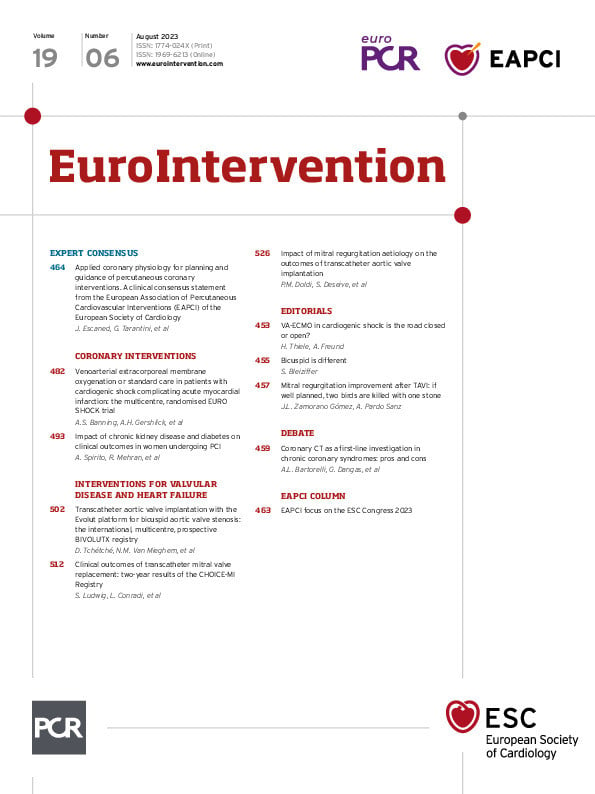Against the background of a persistently high mortality of patients with cardiogenic shock (CS) following acute myocardial infarction (AMI), the use of mechanical circulatory support (MCS) has increased significantly in recent years. This is especially notable in the field of venoarterial extracorporeal membrane oxygenation (VA-ECMO), which is reflected in the continuously rising number of hospitals capable of using the system1. However, until recently, the underlying evidence in AMI-CS was limited to small observational studies indicating a possible survival benefit of early VA-ECMO support and one very small randomised controlled trial (RCT) that found no superiority of extracorporeal life support (ECLS) with respect to its primary endpoint, left ventricular ejection fraction, at 30 days23. International guidelines recommend considering the use of active MCS in refractory CS45. These recommendations were recently challenged by the results of the ECMO-CS trial, the largest published RCT to date in the field of VA-ECMO, and also of active mechanical circulatory support in CS6. The trial included 117 patients with severe or rapidly deteriorating CS of different aetiologies and demonstrated no benefit of upfront VA-ECMO compared to early conservative therapy with the possibility of downstream VA-ECMO regarding the primary endpoint of all-cause mortality, resuscitated circulatory arrest, and implementation of another MCS device. Against this background, the results of the 3 large RCTs examining the effect of VA-ECMO versus standard therapy in CS (EURO SHOCK, ECLS-SHOCK and ANCHOR) have been awaited with great anticipation.
In the current issue of EuroIntervention, Banning et al report the results of the EURO SHOCK trial7. The study was funded by the European Union and was planned to include 428 patients. However, due to challenges in recruitment, the trial was stopped prematurely after randomisation of only 35 patients at 15 centres in 6 European countries.
Eligible patients had AMI and persistent CS 30 minutes after attempted revascularisation of the culprit lesion by percutaneous coronary intervention (PCI). Of the 35 patients included, 17 were randomised to VA-ECMO and 18 to standard therapy. Only 12 of the 17 patients (70.6%) in the VA-ECMO group actually underwent implantation of the device. The primary endpoint of 30-day all-cause mortality occurred in 43.8% of the VA-ECMO group and in 61.1% of the control group; at 1-year, mortality was 51.8% and 81.5%, respectively. The small number of patients, and thus significant reduction in power, allow only for a descriptive evaluation of the results. Vascular and bleeding complications were observed more frequently in the VA-ECMO group.
With the premature stop of EURO SHOCK, it ranks among the very small RCTs in CS. The COVID-19 pandemic, which coincided with the start of recruitment, is cited as the main recruitment problem. ECMO devices were in short supply during the peaks of the pandemic. Whether regulatory requirements also impeded recruitment was not addressed. However, these far-reaching effects on a relevant clinical trial should be discussed critically at all levels. On the other hand, there are RCTs in the field of MCS therapy in CS which were able to continue recruiting during the pandemic. Thus, it needs to be debated whether the slow recruitment in EURO SHOCK was solely caused by COVID-19, especially since the inclusion rate of screened patients was only 10%. Recruitment of patients with CS and possible indication for VA-ECMO is challenging even outside the circumstances of the pandemic. These challenges include the overall acuity of the disease, the need for thoughtful determination of eligibility criteria in a heterogeneous collective of patients, the incapability of patients to give informed consent and, finally, the possible concern of treating clinicians of withholding a potentially life-saving therapy due to lack of evidence. Established shock networks are therefore indispensable for optimising clinical care and ensuring adequate recruitment into trials.
How can the results of the present trial be put into perspective? It could be postulated that the VA-ECMO group has a numerical survival advantage, which differs from the findings of the larger ECMO-CS trial. However, one should be cautious about overinterpretation given the actual power of the trial and the risk of chance findings. The lack of ability to draw conclusions is also emphasised by the authors.
Consequently, results from larger trials are needed to assess the role of VA-ECMO in AMI-CS. However, the design of the pending RCTs ECLS-SHOCK (n=420, Germany/Slovenia), which is expected to be published later this year, and ANCHOR (n=400, France) differ from key aspects of EURO SHOCK. In particular, ECLS-SHOCK demands VA-ECMO implantation before or during revascularisation, as observational data emphasise the implementation of VA-ECMO therapy prior to revascularisation89. Thus, the EURO SHOCK trial, in its original setup, would have been an important addition to the body of evidence and especially to the ongoing debate on the timing of VA-ECMO.
Conflict of interest statement
The authors have no conflicts of interest to declare.

